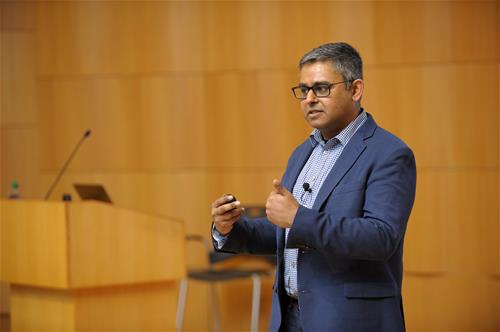
Nov 1, 2019 2019-11 Business Administration Student
Hallene Lecture explores intersection of artificial intelligence and public safety
“Design, AI, and public safety are not three separate entities. They are all one.”
That’s how Mahesh Saptharishi set the tone for the Fall 2019 Hallene Lecture, hosted by The Hoeft Technology & Management (T&M) Program. Saptharishi is senior vice president and chief technology officer at Motorola Solutions, which has served as a T&M corporate affiliate since 2003. Saptharishi was joined by Motorola Solutions’ Head of AI & Analytics Jehan Wickramasuriya and Director of User Experience Design & Research Lexie Spiro for the lecture, which centered around high-velocity assisted intelligence. Saptharishi offered a public safety perspective on why a new framework for design thinking is necessary to transform recent advances in artificial intelligence into powerful tools to assist those charged with our safety.
“Our focus with AI is how we can make the tasks of public safety officers faster and more effective,” Saptharishi said. “That interaction with a human user is something we want to optimize. That makes design extremely important.”
effective,” Saptharishi said. “That interaction with a human user is something we want to optimize. That makes design extremely important.”
When police officers stop a driver for a traffic violation, they’re trained to think about it as a very dangerous, tense situation. The cognitive state of the person in the car is very different from the cognitive state of the police officer. That situation, Saptharishi says, needs to be carefully considered when designing solutions. Companies like Motorola Solutions must keep these particular users in mind, making sure to solve very specific problems.
“There’s a cognitive state of the user we need to be aware of when thinking about public safety applications,” Saptharishi said. “It’s a state of mind where people are under great stress. They have a job to do, maybe save a life. Innovation is desperately needed in the world of public safety.”
“As a human, our core value is thinking in ways machines cannot,” Wickramasuriya added. “We’re not building AI to find a needle in a haystack; we’re using it to clear the hay so the human can find the needle.”
In the eyes of Motorola Solutions, public safety is an end-to-end workflow. First responders prepare for what might happen in the future, detect what is happening at that moment, respond to the problem, and then resolve the situation. AI does not sit on top of the workflow as an all-knowing being directing all the work, said Wickramasuriya. The magic lies in the user experience, the inclusive aspect. AI should be inserted into specific parts of the workflow to help with meaningful tasks as the user needs them. Ultimately that operational success comes down to efficient, effective design.
“We can do amazing, incredible things with AI, but we need to avoid bad design,” Spiro said. “AI needs to be intuitively designed, so it’s clearly communicated how the user is supposed to interact and what responsibility the user assumes.”
Spiro illustrated this concept through four factors: trust, context, feedback, and adaptation. It’s critical, he said, to design experiences that build trust, not detract from it. Dispatchers who have been performing their job for many years need to have the trust to embrace this added technology, not resist it.
Context means tethering AI capabilities to certain portions of the workflow, ensuring that the power of AI is being used for its intended purpose. Feedback and adaptation, Spiro added, go hand in hand, building the connection between the user and software. When designed and operated correctly, as the software matures, it becomes more tethered to how the human would expect to interact with it.
“The goal of doing AI and design together is understanding that inside any workflow, there are many monotonous tasks,” Saptharishi said. “We want AI to compress all of that, eliminate redundancy, and make it easy for public safety officials to get what they need as quickly as possible in order to maximize their lifesaving capabilities.”
About the Hallene Lecture Series
The Hallene Lecture Series honors the memory of Alan M. Hallene (’51), former president of Montgomery Company in Moline, Illinois. He served as president of both the Alumni Association and the U of I Foundation Board of Directors. He was the recipient of two of the University’s highest honors: the Alumni Association Achievement Award and the U of I Foundation’s Presidents Award. In 2001, the John D. and Catherine T. MacArthur Foundation made a gift to The Hoeft Technology & Management Program to establish this lecture series. The gift honors Mr. Hallene, who was a member of the MacArthur Foundation Board of Directors. Mr. Hallene passed away in April 2004, and he is survived by his wife Phyllis and children Alan Jr., Carol, Janet, and James.
